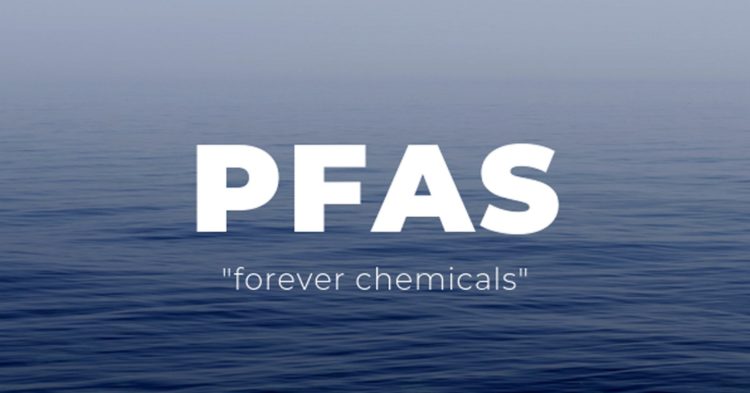Organic contaminants such as lead, arsenic and pesticides have long been on the national radar as serious health threats. But recently, a new class of chemicals has emerged that has been making headlines due to their toxicity, prevalence and constancy. What are “forever chemicals”? They are toxic compounds more formally known as PFAS, short for per- and polyfluoroalkyl substances. They are a class of man-made chemicals long used by manufacturers to make certain products grease-proof, water-proof, stick-proof, and stain-resistant. Due to their widespread use in thousands of everyday consumer and industrial products ranging from food packaging to cookware, cosmetics, and stain- and waterproof fabrics, they are now pervasive in the environment including the air, soil and water. According to the U.S. Center for Disease Control, nearly the entire global population has some measure of PFAS in their body.
Items that may contain PFAS, include:
- Food packaging: food wrappers, pizza boxes, microwave popcorn bags, take-out containers, and disposable trays
- Paper / plastic cups, plates, and utensils
- Cookware: especially non-stick pans (Teflon)
- Personal care products: cosmetics, lipstick, foundation, mascara, lotions, dental floss, and period products
- Stain-proof and waterproof clothing
- Outdoor gear
- Carpets, rugs, furniture textiles, window treatments, and car seats
- Cleaning products
- Sealants, solvents, adhesives, and glues
- Building products
- Furniture
- Touchscreens
- Medical equipment: medical garments, pacemakers, MRI Imaging Devices
- Firefighting foam and equipment
- Drinking water
- And more…
PFAS are called “forever chemicals” because they do not break down in the environment, ever. Essentially, the same properties that make them so useful and effective in consumer products are also what makes them indestructible and thus, so pervasive. They can move through soil and contaminate water sources that we drink, bathe, and cook with. PFAS are increasingly found in rivers and lakes, and animals on land and in the water. Exposure to people primarily occurs by consuming PFAS-contaminated water or food. It may also occur by using products that contain PFAS.
Exposure to PFAS increases the risk of a wide variety of health problems due to the effect they have on the immune system. This can lead to:
- Immunosuppression
- Kidney disease & kidney cancer
- Testicular cancer
- Liver damage
- Ulcerative colitis
- Thyroid disease
- Endocrine (hormonal) disruption & obesity
- High cholesterol
- Asthma
- Decreased fertility
- Low birth rate
- Pregnancy-induced hypertension
Scientists and industry leaders have been aware of the health risks of PFAS since the 1950s when they were first discovered in the blood of factory workers and cigarette smokers. Unfortunately, it wasn’t until around 1998 when a farmer in West Virginia saw 200 of his cattle die and family members become ill after Dupont put in a nearby landfill, through which a creek flowed before spilling into the farmer’s pasture. That case was settled in 2001 but later morphed into a class action lawsuit.
U.S. industry subsequently voluntarily halted production of two of the toxic PFAS: PFOA (perfluorooctanoic acid) and PFOS (perfluorooctanesulfonic acid). However, other countries still use them in manufacturing; they have already contaminated water systems across the country and the world; and again, they do not go away by themselves. In addition, while PFOA and PFOS were phased out, there are thousands of other variants of these chemicals with similar properties that have similar effects on people.
The proliferation of PFAS, the negative health impacts that are associated with them that we are witnessing over time, and the government’s acknowledgment that they are seriously harmful are some of the reasons that stories about contaminated public water systems in Michigan, Mississippi and Camp Lejeune are all over America’s headlines.
The good news is that there are ways to avoid exposure to PFAS. Although manufacturers need to stop using these kinds of chemicals (more brands are increasingly pledging to go PFAS-free) and the government needs to more aggressively regulate or ban them; there are also actions that individuals can take. This includes avoiding PFAS products, using them properly when needed (such as not overheating non-stick cookware), and using water filtration.
Point-of-entry water treatment systems like UDI’s Hydro-5 STS® are whole-house treatment systems designed to reduce contaminants in water intended for drinking, cooking, showering, washing dishes and clothes, and brushing teeth. More than a simple water softener, which helps reduce some heavy metals along with water hardness, water processing systems like the Hydro-5 STS® remove both organic and inorganic contaminants, as well as particulates such as sand, rust and silt.
This water refiner, softener, clarifier and filter not only removes objectionable water tastes, odors, chemicals and turbidity, and softens water, but it also removes radioactive compounds and raises the pH of acidic water.
For maximum protection, a purification system like UDI’s Ultra-6® Reverse Osmosis System adds a 6-stage variable filtration system that includes reverse osmosis, carbon filtration, and KDF/GAC filtration; an RO membrane that removes TDS (total dissolved solids); and carbon post-filtering. The EPA agrees that “high-pressure membranes, such as nanofiltration or reverse osmosis, have been extremely effective at removing PFAS. Research shows that these types of membranes are typically more than 90 percent effective at removing a wide range of PFAS, including shorter chain PFAS.”
Request a free at-home water test with UDI to find out the quality of your water! We can discuss your options based on your test results, goals and budget. Call UDI toll-free at 1-800-741-4426 or fill out a contact form on our website.



